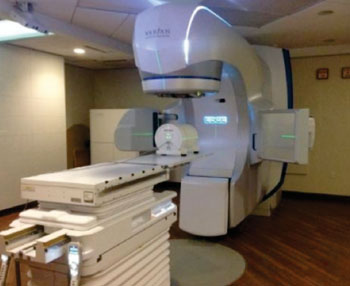New Radiosurgery Technology Used to Treat Tumors Encroaching on Patient’s Spinal Cord
By MedImaging International staff writers
Posted on 11 Nov 2014
A 71-year-old man with a tumor encroaching on his spinal cord was among the first individuals to receive treatment using a new radiosurgery system. The radiosurgery platform provides clinicians with a rapid, precise, noninvasive alternative to traditional surgery.Posted on 11 Nov 2014
“The Edge system is ideal for this kind of case, which requires tremendous precision,” said Beatriz Amendola, MD, medical director at Innovative Cancer Institute (Miami, FL, USA), where the system was recently installed. “It enables us to deliver high doses very quickly, with great accuracy, helping us avoid adjacent critical structures. We were able to confidently treat the tumor, which was beginning to impinge on the patient’s spinal cord, and get the patient back to normal life after just one treatment session. Without treatment, the spinal compression would have worsened, and most likely progressed to severe pain and paralysis.”

Image: Varian’s Edge radiosurgery system (Photo courtesy of Varian).
Innovative Cancer Institute is and one of only five sites in the United States, to have commenced treating patients using the new Edge system, developed by Varian Medical Systems (Palo Alto, CA, USA). “We’re excited to be among the earliest adopters of this exciting new technology,” Dr. Amendola said. “Our plan is to use it to expand our radiosurgery practice, starting with primary and metastatic spinal tumors, followed by skull base and other head and neck lesions. We will also use the system to treat lung cancer; metastatic tumors in places like the liver, lung, and adrenal gland; and radio-resistant tumors such as melanoma and renal cell cancer.”
The Edge radiosurgery system enables clinicians to attack tumors rapidly and noninvasively, using precisely shaped high-energy X-ray beams. There are no incisions and patients contend with few of the healing, pain, and recovery issues associated with traditional surgery. The system integrates Varian’s most sophisticated medical linear accelerator—a device that produces the high energy X-ray beams used to treat disease—with tools for real-time imaging, tumor tracking, motion management, and patient positioning.
“The Edge system enables us to treat multiple metastases at the same time, sometimes in a single treatment session rather than one-by-one, which is required when using some other radiosurgery systems,” Dr. Amendola said. “That capability gives the Edge system a tremendous efficiency advantage when treating a patient with more than one tumor.”
“Prior to the development of technology for spine radiosurgery, inoperable patients were left without any options other than to manage severe and chronic pain with narcotic analgesia,” Dr. Amendola said. “It’s gratifying to see that we can achieve high levels of pain control for these patients using radiosurgery.”
Dr. Amendola foresees that the use of radiosurgery will greatly increase in the future, as physicians become more aware of how the field has evolved. “We’re going to see much faster usage growth for treating tumors outside the head than we saw for treating brain tumors, as more and more oncologists and primary care physicians become aware of the power of this technique.”
Varian’s devices, including the Edge radiosurgery system, have been cleared by the US Food and Drug Administration (FDA) for treating lesions, tumors, and conditions anywhere in the body when radiation treatment is indicated.
Related Links:
Innovative Cancer Institute
Varian Medical Systems














